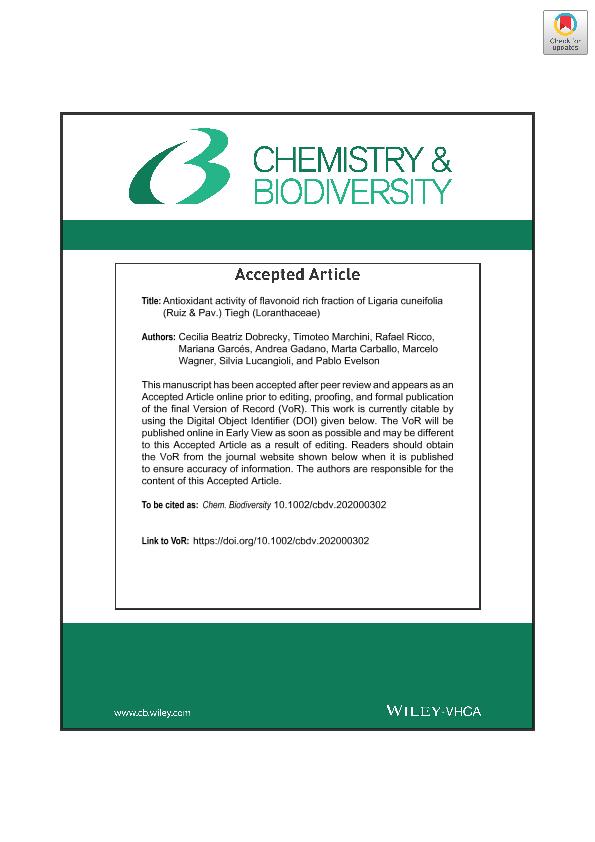Artículo
Antioxidant Activity of Flavonoid Rich Fraction of Ligaria cuneifolia (Loranthaceae)
Dobrecky, Cecilia Beatriz; Marchini, Timoteo Oscar ; Ricco, Rafael Alejandro; Garcés, Mariana; Gadano, Andrea; Carballo, Marta Ana; Wagner, Marcelo; Lucangioli, Silvia Edith
; Ricco, Rafael Alejandro; Garcés, Mariana; Gadano, Andrea; Carballo, Marta Ana; Wagner, Marcelo; Lucangioli, Silvia Edith ; Evelson, Pablo Andrés
; Evelson, Pablo Andrés
 ; Ricco, Rafael Alejandro; Garcés, Mariana; Gadano, Andrea; Carballo, Marta Ana; Wagner, Marcelo; Lucangioli, Silvia Edith
; Ricco, Rafael Alejandro; Garcés, Mariana; Gadano, Andrea; Carballo, Marta Ana; Wagner, Marcelo; Lucangioli, Silvia Edith ; Evelson, Pablo Andrés
; Evelson, Pablo Andrés
Fecha de publicación:
07/2020
Editorial:
Wiley VCH Verlag
Revista:
Chemistry and Biodiversity
ISSN:
1612-1872
Idioma:
Inglés
Tipo de recurso:
Artículo publicado
Clasificación temática:
Resumen
Ligaria cuneifolia (Ruiz & Pav.) Tiegh. (Loranthaceae), the ‘Argentine mistletoe’, is a hemiparasite species largely used in folk medicine. The aim of this study was to evaluate the antioxidant activity using in vitro, ex vivo, and in vivo methods. A screening of phenolics was performed by UV spectroscopy on different fractions. The antioxidant capacity was evaluated in vitro by the 1,1-diphenyl-2-picrylhydrazyl radical (DPPH.) assay on a crude extract (CE), ethyl acetate fraction (EAF), and aqueous fraction (AF). The results suggest that EAF concentrates the antioxidant capacity and was selected for further analysis. Capillary electrophoresis was employed to monitor the individual antioxidant capacity and the potential contributors to this effect. Ex vivo assays showed an efficient inhibition of tert-butyl hydroperoxide-induced rat liver phospholipid oxidation, as well as rat brain autoxidation, and H2O2-induced DNA damage in blood monocytes. In vivo, the topical application of EAF significantly decreased skin chemiluminescence in a mice model.
Archivos asociados
Licencia
Identificadores
Colecciones
Articulos(IBIMOL)
Articulos de INSTITUTO DE BIOQUIMICA Y MEDICINA MOLECULAR
Articulos de INSTITUTO DE BIOQUIMICA Y MEDICINA MOLECULAR
Citación
Dobrecky, Cecilia Beatriz; Marchini, Timoteo Oscar; Ricco, Rafael Alejandro; Garcés, Mariana; Gadano, Andrea; et al.; Antioxidant Activity of Flavonoid Rich Fraction of Ligaria cuneifolia (Loranthaceae); Wiley VCH Verlag; Chemistry and Biodiversity; 17; 10; 7-2020; 1-33
Compartir
Altmétricas



